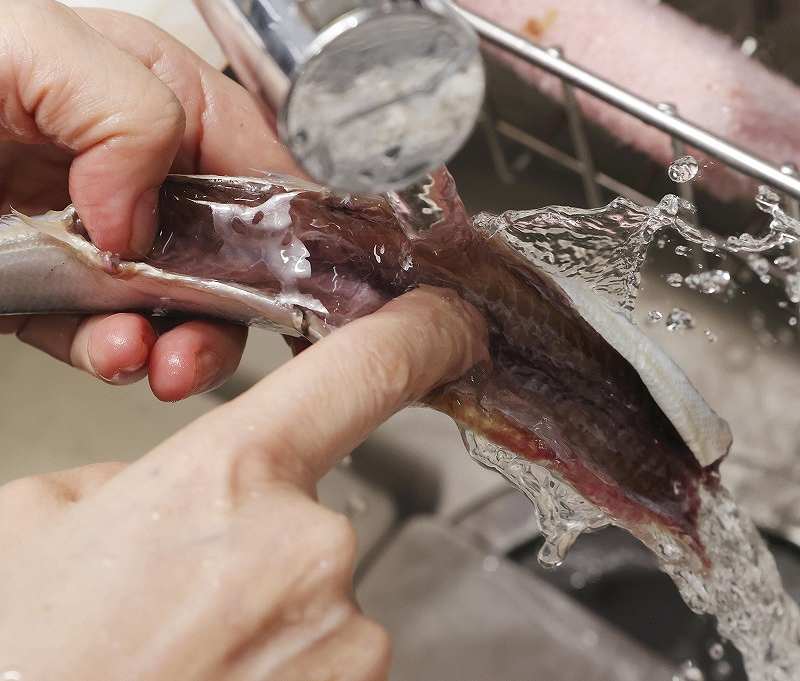
Shallow-fried saury with negishio-dare sauce, foreground, and takikomi gohan with saury and dried daikon.
12:00 JST, October 29, 2022
Early catches of saury are appearing on shelves. Although recent years have seen poor catch volumes continue, eating a mouthful of the fatty fish is a highlight of autumn in Japan.
Saury prices have been on the rise due to falling catch volumes, and the situation often becomes the topic of news reports. According to the Japan Fisheries Research and Education Agency, a national research and development body, the total volume of saury approaching the sea around Japan this year is estimated to be 1.17 million tons.
Though the figure continues to be low, the agency said this year’s figure will be higher than last year’s, which was a record low.
Yasuhiro Yamazaki, president of Yamaharu, an intermediary fish wholesaler at the Toyosu Market in Tokyo, said, “Because many of the fish are relatively small, I recommend trying various ways of cooking them in addition to the orthodox method of frying with salt.”
Cooking instructor Eiko Yanagisawa explains how to better cook this precious resource.
Her first recipe is for shallow-fried saury. Basting it with negishio-dare sauce complements the aroma, and also gives the dish a Chinese flavor.
By soaking the fish in water with the same saltiness as seawater, any bad odor is removed and the meat can be seasoned. Frying over low heat for a long time can prevent failure.
Yanagisawa said, “If you frequently move the fish around, the skin may come off or the meat may break up. Be careful of this.” The bones are removed when you eat the fish. Negishio-dare sauce can be stored in the refrigerator for several days.
Fried saury with negishio-dare
Ingredients (serves 2)
- 2 saury
- ⅓ long negi onion
- ½ tsp grated ginger
- ½ tsp grated garlic
- 1 tsp Chinese stock powder
- ½ cup rice oil or canola oil
Directions:
1. Chop negi onion into pieces and place in a container. Add grated ginger, grated garlic, 1 tablespoon vinegar, ¼ teaspoon salt, Chinese stock powder and 2-3 tablespoons of water. Mix the ingredients. Cover container loosely and heat mixture for about one minute in a 600 W microwave.

Internal organs are removed by running a finger along the bones, thus removing the bitter or fishy taste.
2. Cut head off saury and slice each fish into rounds 4-5 centimeters thick. Remove internal organs, wash fish under running water and pat dry. Soak in salted water (1 teaspoon of salt per 1 cup of water) for about three minutes, and then pat dry.
3. Sprinkle a scant amount of pepper and coat the ingredients lightly with 3 tablespoons of kata-kuriko starch. Put rice oil into a frying pan and fry fish over medium-low heat for about five minutes. When the meat is cooked, turn over. Shallow-fry for about three minutes. Take out of frying pan and remove excess oil.
4. Place on a plate and baste with sauce.
The other dish is takikomi gohan seasoned rice containing saury and kiriboshi-daikon, which are dried daikon radish strips. Its aroma stimulates the appetite. The delicate aroma of saury and ginger billows out from the rice cooker.
It is better to remove all of the internal organs to prevent a fishy taste. You may feel there is not enough salt, but just a little is fine.
Takikomi gohan with saury
Ingredients (serves 2-3)
- 2 saury
- 20 grams kiriboshi-daikon dried radish strips
- 1 piece ginger
- 720 cc rice
- 3 tbsp shirodashi soup stock
- Thin negi onions, as desired
Directions:
1. Make a cut in the belly of the saury, remove the internal organs, cut off the head and tail, rinse under running water and pat dry. Cut the fish in half so that it will fit in a rice cooker. Sprinkle lightly with salt and grill in a toaster oven or fish grill for about 10 minutes.
2. Wash dried daikon radish strips by hand, squeeze to remove excess water and cut into 2-centimeter-long pieces. Slice ginger into very thin pieces. Place rice, 360 ml of water and shirodashi soup stock in a rice cooker. Combine the ingredients.
3. Place the grilled saury on top, and cook the rice on a normal cooking mode. When the rice is cooked, take out the saury, remove the bones and break into pieces.
4. Return the saury to the rice cooker, mix roughly and serve the dish in bowls. Sprinkle with thinly sliced negi. The herb mitsuba can be used instead of negi.
Yanagisawa said: “Saury can be tasty simmered or prepared meuniere-style. I want people to cook the fish in various ways and enjoy the taste of autumn.”
"Features" POPULAR ARTICLE
-

Sanrio to Open Museum in Yamanashi Pref. Dedicated to Founder, Exhibits Include Hello Kitty, Other Characters
-

Autumn Foliage Surrounds Visitors to Tokyo’s Showa Kinen Park
-

My Daughter No Longer Speaks to Me, But I Want to See Her and My Grandchild
-

Kumamoto: Public Bath Refurbished as Library Where You Can Chat, Take Photos
-

Frozen Vegetables: Demand Rises for Convenient, Tasty Domestic Produce
JN ACCESS RANKING
-

Keidanren Chairman Yoshinobu Tsutsui Visits Kashiwazaki-Kariwa Nuclear Power Plant; Inspects New Emergency Safety System
-

Imports of Rare Earths from China Facing Delays, May Be Caused by Deterioration of Japan-China Relations
-

University of Tokyo Professor Discusses Japanese Economic Security in Interview Ahead of Forum
-

Japan Pulls out of Vietnam Nuclear Project, Complicating Hanoi’s Power Plans
-

Govt Aims to Expand NISA Program Lineup, Abolish Age Restriction




















